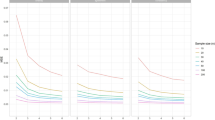Abstract
The well-established a priori probability of illness threshold in medical decision making, introduced by Pauker and Kassirer (N Engl J Med 293:229–234, 1975; N Engl J Med 302:1109–1117, 1980), involves the diagnostic risk only. We generalize the threshold analysis by adding the therapeutic risk, i.e., in accounting for the risk that a treatment might sometimes fail. We derive a priori probability of illness threshold as a function of the probability of successful treatment, as well as the inverted function, where the successful treatment probability threshold is a function of the a priori probability of illness. The thresholds in the general model are higher than those in the special cases where one of the two risks is absent. Applications show that the changes in the thresholds can be substantial. Our general model might explain empirical findings of much higher thresholds than the Pauker–Kassirer model suggests.



Similar content being viewed by others
Notes
For example, if health is measured in remaining life years and a successful treatment will lead to 10 remaining life years, no treatment to 7 remaining life years and unsuccessful treatment to 6 remaining life years, \(s_{d} = u\left( {10} \right) - u\left( 7 \right) > 0\) and \(f_{\text{d}} = u\left( 7 \right) - u\left( 6 \right) > 0\).
References
Pauker, S.G., Kassirer, J.P.: Therapeutic decision making: a cost-benefit analysis. N. Engl. J. Med. 293, 229–234 (1975)
Pauker, S.G., Kassirer, J.P.: The threshold approach to clinical decision making. N. Engl. J. Med. 302, 1109–1117 (1980)
Eeckhoudt, L.: Studies in risk and uncertainty. In: Risk and Medical Decision Making, vol. 14, Springer US, Boston, MA (2002). https://doi.org/10.1007/978-1-4615-0991-2
Eisenberg, J.M., Hershey, J.C.: Derived thresholds. Determining the diagnostic probabilities at which clinicians initiate testing and treatment. Med. Decis. Making 3, 155–168 (1983)
Young, M.J., Eisenberg, J.M., Williams, S.V., Hershey, J.C.: Comparing aggregate estimates of derived thresholds for clinical decisions. Health Serv. Res. 20, 763–780 (1986)
Basinga, P., Moreira, J., Bisoffi, Z., Bisig, B., Van den Ende, J.: Why are clinicians reluctant to treat smear-negative tuberculosis? An inquiry about treatment thresholds in Rwanda. Med. Decis. Making 27, 53–60 (2007)
Sreeramareddy, C.T., Rahman, M., Harsha Kumar, H.N., et al.: Intuitive weights of harm for therapeutic decision making in smear-negative pulmonary tuberculosis: an interview study of physicians in India, Pakistan and Bangladesh. BMC Med. Inform. Decis. Making 14, 67 (2014)
Hozo, I., Djulbegovic, B.: When is diagnostic testing inappropriate or irrational? Acceptable regret approach. Med Decis Making 28, 540–553 (2008)
Roy, P.M., Colombet, I., Durieux, P., Chatellier, G., Sors, H., Meyer, G.: Systematic review and meta-analysis of strategies for the diagnosis of suspected pulmonary embolism. BMJ 331, 259 (2005)
Hull, R.D.: Diagnosing pulmonary embolism with improved certainty and simplicity. JAMA 295, 213–215 (2006)
Haering, A., Heinrich, T., Mayrhofer T.: Exploring the consistency of higher-order risk preferences: Ruhr Economic Papers; 2017. Report No.: 3867887985
Krieger, M., Mayrhofer, T.: Patient preferences and treatment thresholds under diagnostic risk. Ruhr Economic Papers No. 321, Essen, Germany (2012)
Heinrich, T., Mayrhofer, T.: Higher-order risk preferences in social settings. Exp. Econ. 1–23 (2017)
Eeckhoudt, L.R., Lebrun, T.C., Sailly, J.C.: The informative content of diagnostic tests: an economic analysis. Soc. Sci. Med. 18, 873–880 (1984)
Sox, H.C.: Medical decision making. American College of Physicians, Philadelphia (2007)
Felder, S., Mayrhofer, T.: Risk preferences: consequences for test and treatment thresholds and optimal cutoffs. Med. Decis. Making 34, 33–41 (2014)
Djulbegovic, B., van den Ende, J., Hamm, R.M., et al.: When is it rational to order a diagnostic test, or prescribe treatment: the threshold model as an explanation of practice variation. Eur. J. Clin. Invest. 45, 485–493 (2015)
Djulbegovic, B., Hozo, I., Schwartz, A., McMasters, K.M.: Acceptable regret in medical decision making. Med. Hypotheses 53, 253–259 (1999)
Djulbegovic, B., Hozo, I., Beckstead, J., Tsalatsanis, A., Pauker, S.G.: Dual processing model of medical decision-making. BMC Med. Inform. Decis. Mak. 12, 94 (2012)
Mukherjee, K.: A dual system model of preferences under risk. Psychol. Rev. 117, 243–255 (2010)
Wakker, P.P.: Lessons learned by (from?) an economist working in medical decision making. Med. Decis. Making. 28, 690–698 (2008)
Felder, S., Mayrhofer, T.: Introduction. In: Medical Decision Making. Springer, Berlin, Heidelberg (2017). https://doi.org/10.1007/978-3-662-53432-8_1
Eeckhoudt, L., Lebrun, T., Sailly, J.C.: Risk-aversion and physicians’ medical decision-making. J Health Econ 4, 273–281 (1985)
Courbage, C., Rey, B.: Decision thresholds and changes in risk for preventive treatment. Health Econ. 25, 111–124 (2016)
Krieger, M., Mayrhofer, T.: Prudence and prevention: an economic laboratory experiment. Appl. Econ. Lett. 24, 19–24 (2017)
Courbage, C., Rey, B.: Prudence and optimal prevention for health risks. Health Econ. 15, 1323–1327 (2006)
Eeckhoudt, L., Gollier, C.: The impact of prudence on optimal prevention. Econ. Theor. 26, 989–994 (2005)
Berger, L., Bleichrodt, H., Eeckhoudt, L.: Treatment decisions under ambiguity. J. Health Econ. 32, 559–569 (2013)
Author information
Authors and Affiliations
Corresponding author
Appendix
Appendix
Curvature of the threshold functions
The treatment threshold function [Eq. (4)], the test threshold function [Eq. (8)] and the test-treatment threshold function [Eq. (10)] are all negatively sloped and convex. The proofs are analogous. We present the proof for the treatment threshold function.
Equation (4) can be transformed to
Then, the first derivative is negative
as \(s_{\text{d}} ,f_{\text{d}} ,s_{\text{h}} ,f_{\text{h}} > 0\). For the second derivative, we obtain
which is positive provided that \(s_{\text{h}} + f_{\text{d}} + s_{\text{d}} > f_{\text{h}}\). The latter inequality is satisfied for \(0 \le p^{Rx} \left( \pi \right) \le 1\).
Rights and permissions
About this article
Cite this article
Felder, S., Mayrhofer, T. Threshold analysis in the presence of both the diagnostic and the therapeutic risk. Eur J Health Econ 19, 1019–1026 (2018). https://doi.org/10.1007/s10198-017-0951-1
Received:
Accepted:
Published:
Issue Date:
DOI: https://doi.org/10.1007/s10198-017-0951-1




